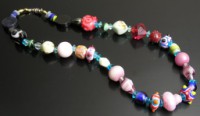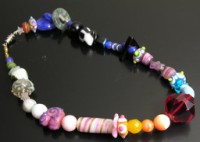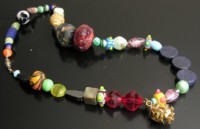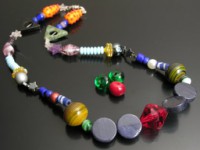Over and over and over I've ranted how people denigrate stringing, because it's ‘so simple even a child can do it.’ Well, yes, indeed they can, as this post proves. But it points up another, less known theory proposed (or at least promulgated) by Betty Edwards: kids often have stronger design sense than adults.
There's a couple of reasons for this. A big one, of course is that most children have not yet learned that art is something only special, “artistic” people can do—they're not afraid of failure. Another advantage is that they're not burdened with what I feel are the artificial restrictions that constrain many adults: they're unconcerned with rigid symmetry, and their sense of color is much more free-wheeling. Moreover, the societal symbols—e.g. vulgarity, and other status markers—are absent from their vocabulary. Without exception, all the children loved the ‘red ruby’ beads the best. And without exception, every child who had two of them put them together as a unit (I missed photographing some pieces, unfortunately.)
All of these necklaces were strung by children 5 to 10 years of age.

This photograph is unfortunately rather washed out (did I mention I was still tired?) but note the recurring pink beads, which tie the overall design together. The piece also has strong, but imperfect bilateral symmetry—tight enough to give the piece a nice overall rhythm, but loose enough to cope with minor variations in the beads and give the piece some zing.

The pink to orange sequences to the left of the red faceted center focal illustrate the natural tendancy of children to focus on a ‘unit’ —a sequence of beads 2 to 3 inches long (50–75mm). Then, upon the transition to the next sequence. Ideally one tries to keep the overall design unified, but as these pieces show, it's more important to keep within-sequence patterns coherent. Kids automatically break the design problem down to manageable chunks, and though they can lose track of the overall pattern (all the more difficult with such a disparate mishmash of beads) if the smaller units don't work, the overall piece can't; whereas the reverse just gives a pleasingly free-form appearance.

This in my opinion is the most remarkable piece in the lot, all the more for its being by the youngest child. The rhythm—that is, the flow of shapes—is wonderful. The stringer also has an intuitive grasp of what I call sequencing, that is, relating several beads together to make a unit, or shape. The fancy mixed jasper-chinese dot bead-2 red facet beads-gold pine cone featured in the crop is a particularly good example: the very subtle colors and pattern in the jasper are punched up a little in the somewhat bolder, but still relatively visually complex chinese bead; the opaque red transitions to an equally saturated, but now transparent, pair of faceted beads; the bling factor increases with the gold pine cone, which maintains similar saturation, but is a new shape and texture. Marvelous. Nor is this the only unit: note the way the rather ugly lampwork beads were put side-by-side near the back, and lightened and brightened with the tan carved wooden oval. —My attention was divided, but this design was neither accidental nor beginner's luck: he took the longest to get going, and most assuredly rearranged and reworked his design (without any adult supervision) to arrive at this piece. This child absolutely adores beads and necklaces, and his joy in them really shows.

This handsome symmetrical piece shows careful attention to color distribution throughout the piece: note the brightest beads are at the rear and center of piece (red and orange dottie cones; red faceted focal), and the secondary blue and yellow stripeys and yellow flowers are spaced pretty evenly; that is, he's varied the intensity of hue to keep the eye moving along: stopping at the brightest colors, slowing at the relatively colorful, skipping over the darker values. The stringer has also used shape repetition very effectively: the large dark-blue disks and small turquoise disks are too dull-toned and too small, respectively, to compete on their own; but arranged in sets, they have sufficient visual punch to look good with other, more visually exciting beads.
The three beads in the center are the stringer's first effort at lampwork, and again, I was impressed by the kid's focus on basic shape: most beginning beadmakers want to skip the dull old discipline of learning to make a good basic bead to move on to more exciting decoration. However this child was very focused on making beads, which is unusual.
I could go on and on but you get the point: kids naturally break stringing down into levels: lay out rough design (most of them started with the center focal, even if it didn't stay centered) then fill in with sequences. This is an excellent method for designing any kind of linear jewelry.
post created 28dec06.
Unless otherwise noted, text, image and objects depicted therein copyright 1996--present sylvus tarn.
Sylvus Tarn